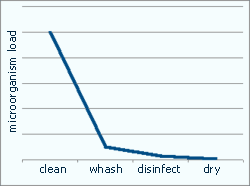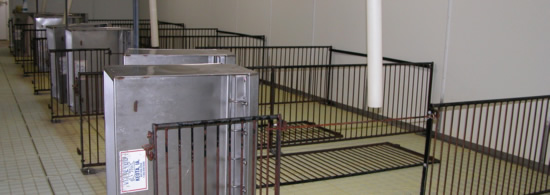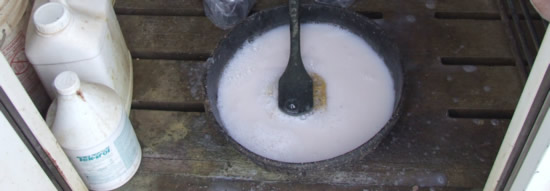Cleaning
Although this seems to be very basic, it is a critical step. One must remove all dirt, bedding, large amounts of feces, leftover feed, and any other organic material from the area. Usually one must start by using brooms , shovels, scrapers, and tipping over feeders. Getting rid of the large organic matter will minimize water usage in the next step as well as minimize the dispersion of all this material with the high pressure water. With our modern facilities, this step is quite simple and usually involves dumping out all feeders as well as pulling the plugs in the pits or running the manure scraper system if applicable. The main goal of this step is to remove the most amount of contaminated material.
Washing
 This is the most critical step of the entire process. This step will remove over 99% of the microorganisms. High pressure (e.g. 2,000 psi) hot water is the most effective in facilitating this process. Having higher volumes of water per minute (e.g. 4 gpm) is also important. For even better results, detergents can be used. Detergents are specially designed products that reduce surface tension and suspend particles from the surface facilitating the cleaning. Detergents can be cationic (positively charged), anionic (negatively charged, or non-ionic (no charge).
This is the most critical step of the entire process. This step will remove over 99% of the microorganisms. High pressure (e.g. 2,000 psi) hot water is the most effective in facilitating this process. Having higher volumes of water per minute (e.g. 4 gpm) is also important. For even better results, detergents can be used. Detergents are specially designed products that reduce surface tension and suspend particles from the surface facilitating the cleaning. Detergents can be cationic (positively charged), anionic (negatively charged, or non-ionic (no charge).
Picture 1. Fully cleaned and washed nursery ready to be disinfected.
Disinfection
The disinfection process will only be effective if the previous washing step was effective in removing all the organic materials. Most of the disinfectants are inactivated by organic material, or if still active, they do not have the power to penetrate large amount of organic material and thereby are unable to do their job (kill microorganisms). In the U.S. all disinfectants are resisted by the Environmental Protection Agency (EPA) as "antimicrobial peptides." It is a federal law violation to use a disinfectant in any way other than how they are labeled.

Picture 2. Foot bath freshly stocked with proper phenolic disinfectant.
To select the proper disinfectant one must know the target organism. Table 1 summarizes the general characteristics of each class of disinfectant. Table 2 summarizes the effectiveness of the different classes of disinfectants on different types of microorganisms. When a swine producer asks me "what disinfectant should I be using Doc?" My answer is always: "Well what are you trying to prevent?"
Table 1. General characteristics of different classes of disinfectants.
| ADVANTAGES | DISADVANTAGES |
| Acids (acetic acid, citric acid) | |
| Destroy nucleic acid bonds | Caustic |
| Precipitate proteins | Can be toxic in air at high concentrations |
| Activity is pH dependant | |
| Limited use | |
| Alcohols (isopropyl and ethyl alcohol) | |
| Denature proteins --> cell lysis | Fire hazard |
| Non-corrosive | Isopropanol is not effective against non-enveloped viruses |
| Effective at 70 - 90% concentrations | |
| Aldehydes (formaldehyde, gluteraldehyde) | |
| Denature proteins | Formaldehyde is carcinogenic (gluteraldehyde is considered safe by EPA) |
| Disrupt nucleic acids | Slight to moderately effective with organic matter |
| Non-corrosive | |
| Slight residue activity | |
| Alkalis (lye, ammonium hydorxide, quicklime) | |
| Saponify lipids in enveloped organisms | Slow activity that increases with temperature |
| Very corrosive | |
| Sodium hydroxide (lye) is effective against FMD | |
| Biguanides (chlorhexidine) | |
| Alter cell permeability | Easily deactivated by soaps, detergents, and hard water |
| Relatively non-irritating to skin | Toxic to fish |
| Halogens (chlorine or iodine compounds) | |
| Denature proteins | Lose potency with time, organic matter, and sunlight |
| Household bleach is 5.25% Sodium hypochlorite | Never mix hypochlorites with acids or ammonia |
| Inexpensive | High concentrations can irritate skin |
| Oxidizing agents (hydrogen peroxide, peracitic acid) | |
| Denature proteins | May be irritating in high concentrations |
| Denature lipids | Moderately corrosive |
| Phenols | |
| Denature proteins | Not effective against non-enveloped viruses |
| Alter cell wall permeability | Concentrations over 2% can be highly toxic to animals especially cats |
| Good effectiveness with organic matter (foot baths – see Picture 2) | |
| Have milky or white color when added to water | |
| Maintain activity in hard water | |
| Have residue after drying | |
| Quaternary ammonium compounds (quats or QAC) | |
| Denature proteins | Not effective against non-enveloped viruses |
| Change cell permeability | Inactivated by organic matter, detergents, soaps, and hard water |
| Toxic to fish | |
Table 2. General antimicrobial spectrum of disinfectants (adapted from CFSPH*).
| Acids | Alcohols | Aldehydes | Alkalis | Biguanides | Halogens | Oxidizing agents | Phenolic comp. | Quaternary ammonia comp. | |
| Mycoplasm. | + | ++ | ++ | ++ | ++ | ++ | ++ | ++ | + |
| Bacteria | + | ++ | ++ | + | ++ | + | + | ++ | + |
| Enveloped viruses (e.g. PRRS) |
+ | + | ++ | + | +/- | + | + | + or +/- | +/- |
| Non-enveloped viruses (e.g. PCV2) |
- | - | + | +/- | - | +/- | +/- | - | - |
| Spores | +/- | - | + | +/- | - | + | - or + | - | - |
| Coccidia | - | - | - | - or + | - | - | - | - or + | - |
| ++Highly effective +Effective +/-Limited effectiveness -No activity NA Data not available | |||||||||
| *Center for Food Security and Public Health at Iowa State University | |||||||||
There is a science to deciding which product you need to use. It is exactly the same process we use in antibiotic selection although in the case of disinfectants we can target both bacteria and viruses. There is no one product that will be effective against all swine pathogens. There is also no scientific evidence to support the idea of rotating disinfectants to prevent resistance building. Disinfectants work in completely different ways than antibiotics.
Disinfectant need to be applied to all surfaces in the proper concentration. Read your product label. Using higher concentrations does not necessarily increase the effectiveness of the product, but rather can double or more your cost of the process. Many disinfectants are now approved to be applied as foams. This process ensures that all surfaces are disinfected adequately and allow longer contact time.
It is critical to remember that all disinfectants need contact time to be effective. The industry standard is 10 minutes. This means that disinfectant need to be in contact with surfaces for at least 10 minutes for them to be effective.
Drying
All microorganisms are living organisms and therefore need water to survive. Allowing surfaces to completely dry is the last effective step in making sure we kill most of the remaining microorganisms. In swine production units this is always a hard step. Farrowing rooms are filled back in soon after the disinfection process has occurred and the room is still wet. On the other hand, nursery and finishing facilities usually are allowed to dry before restocking. In the farrowing house, even giving one day to totally dry two or three times a year may be all you need to help break that disease transmission cycle.
The objective of the cleaning and disinfection process is simple: minimize the bacterial/viral contamination to which pigs are exposed. This lower load of organisms can prevent infection or be low enough to allow the pig's immune system to better fight off the diseases.





